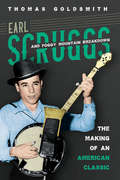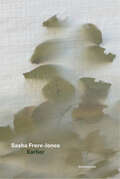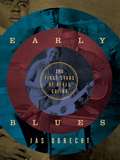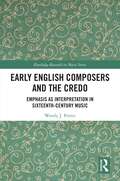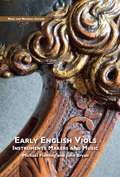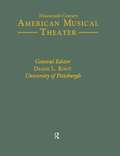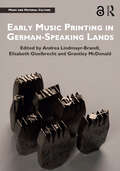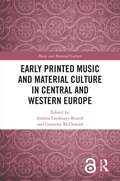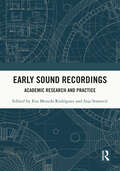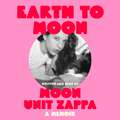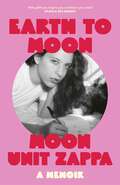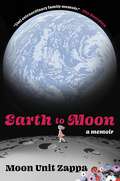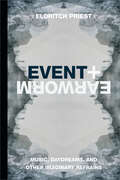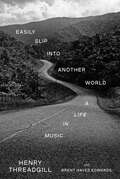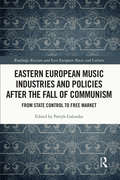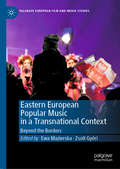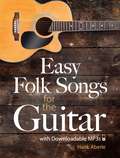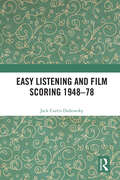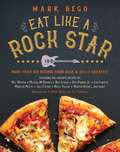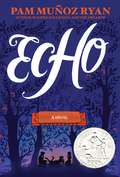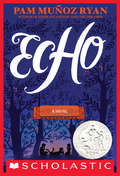- Table View
- List View
Earl Hooker, Blues Master (American Made Music Series)
by Sebastian Danchin2020 Blues Hall of Fame Classic of Blues LiteratureJimi Hendrix called Earl Hooker “the master of the wah-wah pedal.” Buddy Guy slept with one of Hooker's slides beneath his pillow hoping to tap some of the elder bluesman's power. And B. B. King has said repeatedly that, for his money, Hooker was the best guitar player he ever met. Tragically, Earl Hooker died of tuberculosis in 1970 when he was on the verge of international success just as the Blues Revival of the late sixties and early seventies was reaching full volume. Second cousin to now-famous bluesman John Lee Hooker, Earl Hooker was born in Mississippi in 1929, and reared in black South Side Chicago where his parents settled in 1930. From the late 1940s on, he was recognized as the most creative electric blues guitarist of his generation. He was a “musician's musician,” defining the art of blues slide guitar and playing in sessions and shows with blues greats Muddy Waters, Junior Wells, and B. B. King. A favorite of black club and neighborhood bar audiences in the Midwest, and a seasoned entertainer in the rural states of the Deep South, Hooker spent over twenty-five years of his short existence burning up U.S. highways, making brilliant appearances wherever he played. Until the last year of his life, Hooker had only a few singles on obscure labels to show for all the hard work. The situation changed in his last few months when his following expanded dramatically. Droves of young whites were seeking American blues tunes and causing a blues album boom. When he died, his star's rise was extinguished. Known primarily as a guitarist rather than a vocalist, Hooker did not leave a songbook for his biographer to mine. Only his peers remained to praise his talent and pass on his legend. “Earl Hooker's life may tell us a lot about the blues,” biographer Sebastian Danchin says, “but it also tells us a great deal about his milieu. This book documents the culture of the ghetto through the example of a central character, someone who is to be regarded as a catalyst of the characteristic traits of his community.” Like the tales of so many other unheralded talents among bluesmen, Earl Hooker, Blues Master, Hooker's life story, has all the elements of a great blues song—late nights, long roads, poverty, trouble, and a soul-felt pining for what could have been.
Earl Scruggs and Foggy Mountain Breakdown: The Making of an American Classic (Music in American Life #476)
by Thomas GoldsmithRecorded in 1949, "Foggy Mountain Breakdown" changed the face of American music. Earl Scruggs's instrumental essentially transformed the folk culture that came before it while helping to energize bluegrass's entry into the mainstream in the 1960s. The song has become a gateway to bluegrass for musicians and fans alike as well as a happily inescapable track in film and television.Thomas Goldsmith explores the origins and influence of "Foggy Mountain Breakdown" against the backdrop of Scruggs's legendary career. Interviews with Scruggs, his wife Louise, disciple Bela Fleck, and sidemen like Curly Seckler, Mac Wiseman, and Jerry Douglas shed light on topics like Scruggs's musical evolution and his working relationship with Bill Monroe. As Goldsmith shows, the captivating sound of "Foggy Mountain Breakdown" helped bring back the banjo from obscurity and distinguished the low-key Scruggs as a principal figure in American acoustic music.Passionate and long overdue, Earl Scruggs and Foggy Mountain Breakdown takes readers on an ear-opening journey into two minutes and forty-three seconds of heaven.
Earlier (Semiotext(e) / Native Agents)
by Sasha Frere-JonesSasha Frere-Jones&’s evolution as a writer and musician with the deceptively casual intelligence that marks all of his work.Shuttling between his first year of life (1967) and the year he wrote the book (2020), Earlier is a glorious sequence of moments, a record of the experiences that set the shape of a life. Frere-Jones&’s prose floats between clinically precise fragments and emotional impressions of revelations, pleasures, and accidents. It&’s a book about how lives happen and sensibilities form.As fellow music critic Alex Ross observes, &“It is weird to write a book about yourself, as this book is well aware. Gazing in the mirror is not mass entertainment. Sasha Frere-Jones, a writer of nonchalant, rope-a-dope power, drops the illusion of self-knowledge and instead offers up a kaleidoscope of memory shards, faithful to the chaos of inner and outer worlds. Earlier is funny, cool, raw, wise, and secretly sublime.&”Begun in 2010, Earlier was completed at the request of Deborah Holmes, to whom the book is dedicated. Holmes is the mother of Frere-Jones&’s two boys, Sam and Jonah. Diagnosed with pancreatic cancer in July of 2020, Holmes died in January of 2021. Earlier is the last book she read. Frere-Jones says, &“Deborah was the most enthusiastic reader I&’ve ever met. She read when she wasn&’t doing something else, and that never changed. She asked me to write this when we met, in 1990. I am sorry I made her wait so long.&”
Early Blues: The First Stars of Blues Guitar
by Jas ObrechtWinner of the 2016 Living Blues Award for Blues Book of the Year Since the early 1900s, blues and the guitar have traveled side by side. This book tells the story of their pairing from the first reported sightings of blues musicians, to the rise of nationally known stars, to the onset of the Great Depression, when blues recording virtually came to a halt.Like the best music documentaries, Early Blues: The First Stars of Blues Guitar interweaves musical history, quotes from celebrated musicians (B.B. King, John Lee Hooker, Ry Cooder, and Johnny Winter, to name a few), and a spellbinding array of life stories to illustrate the early days of blues guitar in rich and resounding detail. In these chapters, you&’ll meet Sylvester Weaver, who recorded the world&’s first guitar solos, and Paramount Records artists Papa Charlie Jackson, Blind Lemon Jefferson, and Blind Blake, the &“King of Ragtime Blues Guitar.&” Blind Willie McTell, the Southeast&’s superlative twelve-string guitar player, and Blind Willie Johnson, street-corner evangelist of sublime gospel blues, also get their due, as do Lonnie Johnson, the era&’s most influential blues guitarist; Mississippi John Hurt, with his gentle, guileless voice and syncopated fingerpicking style; and slide guitarist Tampa Red, &“the Guitar Wizard.&”Drawing on a deep archive of documents, photographs, record company ads, complete discographies, and up-to-date findings of leading researchers, this is the most comprehensive and complete account ever written of the early stars of blues guitar—an essential chapter in the history of American music.
Early English Composers and the Credo: Emphasis as Interpretation in Sixteenth-Century Music (Routledge Research in Music)
by Wendy J PorterThis book develops an innovative approach for understanding the relationship between music and words in the works of five major composers of the English Renaissance: John Taverner, Christopher Tye, John Sheppard, Thomas Tallis, and William Byrd. Focusing on these composers’ settings of the Latin Credo, the author shows how musical and linguistic emphasis can be used to understand the composers’ theological interpretations of the text. By combining markedness theory with style analysis, this study demonstrates that the composers used their musical skills not only to create beautiful music, but to raise certain elements of the text to the foreground of perception and relegate others to supporting roles, inviting listeners to experience the familiar words of the liturgy in unique ways. Providing new insights into the changing musical and religious world of the sixteenth century, this book is relevant to anyone researching music or religion in early modern England, while offering a flexible and widely adaptable tool for the analysis of musical-textual relationships.
Early English Viols: Instruments, Makers and Music (Music and Material Culture)
by John Bryan Michael FlemingWinner of the Nicholas Bessaraboff Prize Musical repertory of great importance and quality was performed on viols in sixteenth- and early seventeenth-century England. This is reported by Thomas Mace (1676) who says that ’Your Best Provision’ for playing such music is a chest of old English viols, and he names five early English viol makers than which ’there are no Better in the World’. Enlightened scholars and performers (both professional and amateur) who aim to understand and play this music require reliable historical information and need suitable viols, but so little is known about the instruments and their makers that we cannot specify appropriate instruments with much precision. Our ignorance cannot be remedied exclusively by the scrutiny or use of surviving antique viols because they are extremely rare, they are not accessible to performers and the information they embody is crucially compromised by degradation and alteration. Drawing on a wide variety of evidence including the surviving instruments, music composed for those instruments, and the documentary evidence surrounding the trade of instrument making, Fleming and Bryan draw significant conclusions about the changing nature and varieties of viol in early modern England.
Early Melodrama: The Voice of Nature, Music by Victor Pelisser, Script by William Dunlap, 1803 (Nineteenth-Century American Musical Theater Series)
by Karl Kroeger and Fell Yellin VictorPart of a series of sixteen volumes that provides for the first time ever a comprehensive set of works from a full century of musical theater in the United States of America. Many of the volumes contain musical scores and librettos that have never before been published. The work that leads off this volume, The Voice of Nature, is generally considered the first melodrama to be performed in America, and the earliest surviving complete work composed for American professional theater. It is also the first to be written by a playwright boom in America.
Early Music Printing in German-Speaking Lands (Music and Material Culture)
by Andrea Lindmayr-Brandl Elisabeth Giselbrecht Grantley McDonaldThe first century of music printing in Germany had its own internal dynamics, affected by political and social events such as the Reformation. Yet it also had an international dimension: German printers set up shops all around Europe, taking materials and techniques with them, or exporting necessary materials such as type. For the first time, this collection brings together the different strands that define the German music printing landscape from the late fifteenth to the late sixteenth century. From the earliest developments in music printing and publishing, to printing techniques and solutions, the commerce of music printing, and intellectual history, the chapters outline broad trends in the production of different genres of printed books and examine the work of individual printers. The book draws upon the rich information gathered for the online database Catalogue of early German printed music / Verzeichnis deutscher Musikfrühdrucke (vdm), the first systematic descriptive catalogue of music printed in the German-speaking lands between c. 1470 and 1540, allowing precise conclusions about the material production of these printed musical sources. The result is a highly original and varied picture of the beginnings of music printing in a geographical region that, until now, has been somewhat neglected.
Early Musical Borrowing (Criticism and Analysis of Early Music)
by Honey MeconiFirst Published in 2004. Routledge is an imprint of Taylor & Francis, an informa company.
Early Printed Music and Material Culture in Central and Western Europe (Music and Material Culture)
by Andrea Lindmayr-Brandl Grantley McDonaldThis book presents a varied and nuanced analysis of the dynamics of the printing, publication, and trade of music in the sixteenth and early seventeenth centuries across Western and Northern Europe. Chapters consider dimensions of music printing in Britain, the Holy Roman Empire, the Netherlands, France, Spain and Italy, showing how this area of inquiry can engage a wide range of cultural, historical and theoretical issues. From the economic consequences of the international book trade to the history of women music printers, the contributors explore the nuances of the interrelation between the materiality of print music and cultural, aesthetic, religious, legal, gender and economic history. Engaging with the theoretical turns in the humanities towards material culture, mobility studies and digital research, this book offers a wealth of new insights that will be relevant to researchers of early modern music and early print culture alike.
Early Sound Recordings: Academic Research and Practice
by Eva Moreda Rodríguez Inja StanovićThe use of historical recordings as primary sources is relatively well established in both musicology and performance studies and has demonstrated how early recording technologies transformed the ways in which musicians and audiences engaged with music. This edited volume offers a timely snapshot of a wide range of contemporary research in the area of performance practice and performance histories, inviting readers to consider the wide range of research methods that are used in this ever-expanding area of scholarship. The volume brings together a diverse team of researchers who all use early recordings as their primary source to research performance in its broadest sense in a wide range of repertoires within and on the margins of the classical canon – from the analysis of specific performing practices and parameters in certain repertoires, to broader contextual issues that call attention to the relationship between recorded performance and topics such as analysis, notation and composition. Including a range of accessible music examples, which allow readers to experience the music under discussion, this book is designed to engage with academic and non-academic readers alike, being an ideal research aid for students, scholars and performers, as well as an interesting read for early sound recording enthusiasts.
Earshot: Perspectives on Sound
by Bruce JohnsonEarshot: Perspectives on Sound awakens an understanding of the decisive role that sound has played in history and culture. Although beginning with reference to antiquity, the primary focus is the changing status of sound and hearing in Western culture over the last six hundred years, covering the transition from the medieval period to the contemporary world. Since mythic times, sound has been an essential element in the formation of belief systems, personal and community identities and the negotiations between them. The varied case studies included in the book cover major reference points in the changing politics of sound, particularly in relation to the status of the other major conduit of social transactions, vision. Earshot is not a work of cultural theory but is anchored in social practices and material culture and is therefore a valuable resource for conveying sound to both undergraduate students as well as the general reader.
Earth Sound Earth Signal: Energies and Earth Magnitude in the Arts
by Douglas KahnEarth Sound Earth Signal is a study of energies in aesthetics and the arts, from the birth of modern communications in the nineteenth century to the global transmissions of the present day. Grounded in the Aeolian sphere music that Henry David Thoreau heard blowing in telegraph lines and in the Aelectrosonic sounds of natural radio that Thomas Watson heard in telephone lines, the book moves through the histories of science, media, music, and the arts to the 1960s, when the composer Alvin Lucier worked with the "natural electromagnetic sounds" present from "brainwaves to outer space," through the urban electromagnetism in the conceptual art of Robert Barry, to the energy scavenging drawings and antennas by the artist Joyce Hinterding. From the sounds of auroras at high latitudes and atmospheric electricity in the mountains, to underground music of earthquakes and nuclear explosions, to music bounced off the moon and the sounds of the sun, Earth Sound Earth Signal rethinks energy at a global scale through detailed discussions of artists and scientists such as Gordon Mumma, Pauline Oliveros, John Cage, James Turrell, Karl-Birger Blomdahl, Paul DeMarinis, Semiconductor, Thomas Ashcraft, Katie Paterson, Edmond Dewan, Ludwik Liszka and many others.
Earth to Moon
by Moon Unit ZappaThe saying goes that "God only gives you what you can handle." Well God didn't grow up in my atheist, Wiccan, fame-laden, oversexed, teetotalling, drug-free, cloistered, chaotic, non-communicative, workaholic, feral-feeling house.'For Moon Unit, daughter of musician Frank Zappa and his 'manager', Gail, processing a life so unique, so punctuated by the whims of creative urges, the tastes of popular culture and the calculus of celebrity, has at times been eviscerating. But it is her deep sense of humour and unshakeable humility that keeps her - and this memoir - pinned to the ground.A child-star at age 14 after her accidental international hit single (recorded with her father), 'Valley Girl', turned her into a reluctant celebrity, Moon Unit Zappa's life has been utterly extraordinary from her birth in 1967 into a family that was already blessed/cursed as music royalty thanks to the acknowledged genius of Frank. But what are the consequences of growing up in a family who spend most of their time naked arguing about sexual/extra-marital liaisons and practising white magic in a free-for-all state of nonconformist, virtuoso abandon?Earth to Moon is a reckoning with self-esteem, the ghosts of the past and a mother and a father who, in the process of leaving their mark upon on the world, scarred their first daughter on home soil. Brutally self-deprecating and funny as hell, it belies a rose-tinted perspective on the 70s and 80s west coast American scene, from within the belly of the beast of the rock and roll world.
Earth to Moon
by Moon Unit ZappaThe saying goes that "God only gives you what you can handle." Well God didn't grow up in my atheist, Wiccan, fame-laden, oversexed, teetotalling, drug-free, cloistered, chaotic, non-communicative, workaholic, feral-feeling house.'For Moon Unit, daughter of musician Frank Zappa and his 'manager', Gail, processing a life so unique, so punctuated by the whims of creative urges, the tastes of popular culture and the calculus of celebrity, has at times been eviscerating. But it is her deep sense of humour and unshakeable humility that keeps her - and this memoir - pinned to the ground.A child-star at age 14 after her accidental international hit single (recorded with her father), 'Valley Girl', turned her into a reluctant celebrity, Moon Unit Zappa's life has been utterly extraordinary from her birth in 1967 into a family that was already blessed/cursed as music royalty thanks to the acknowledged genius of Frank. But what are the consequences of growing up in a family who spend most of their time naked arguing about sexual/extra-marital liaisons and practising white magic in a free-for-all state of nonconformist, virtuoso abandon?Earth to Moon is a reckoning with self-esteem, the ghosts of the past and a mother and a father who, in the process of leaving their mark upon on the world, scarred their first daughter on home soil. Brutally self-deprecating and funny as hell, it belies a rose-tinted perspective on the 70s and 80s west coast American scene, from within the belly of the beast of the rock and roll world.
Earth to Moon: A Memoir
by Moon Unit ZappaFrom Moon Unit Zappa, the daughter of musical visionary Frank Zappa, comes a memoir of growing up in her unconventional household in 1970s Los Angeles, coming of age in the Hollywood Hills in the 1980s as the “Valley Girl,” gaining momentum as an accidental VJ on a new network called MTV, and finding herself after losing her father, then her mother, and the testing of her most important relationships.How can you navigate life as the “normal” child of an extraordinary creative? What is it like to live in a hothouse of individuality that on one hand fosters freedom of expression, and on the other tamps down the basic desires of a child for boundaries and affection? Should you call your parents Frank and Gail from birth? For Moon Unit Zappa, processing a life so punctuated by the whims of genius, the tastes of popular culture, the calculus of celebrity, and the nature of love, was at times eviscerating, at times illuminating—but mostly deeply confusing. Yes, this is a book about growing up in the shadow of Frank Zappa. Moon and her family were a source of constant curiosity, for their unique names and for their father’s reputation as a musical savant and fierce protector of the First Amendment, even though he was never a commercial success. Searching for her own path, first as her father’s inadvertent musical collaborator and public sidekick with their surprise mega radio hit, then as an actress, an artist, a spiritual person, a wife and mother, Moon Unit calculates ever-changing equations of fame, family, death and ultimately legacy when dealt the shocking news that Gail’s will established an unequal distribution among the remaining, tight-knit Zappas, catalyzing a quest for meaning and redemption. With love, humor, and humility, Earth to Moon reminds us that every family is faced with problems that are unique to their particular makeup, but the journey to growing into yourself with grace is as universal as it gets.
Earworm and Event: Music, Daydreams, and Other Imaginary Refrains (Thought in the Act)
by Eldritch PriestIn Earworm and Event Eldritch Priest questions the nature of the imagination in contemporary culture through the phenomenon of the earworm: those reveries that hijack our attention, the shivers that run down our spines, and the songs that stick in our heads. Through a series of meditations on music, animal mentality, abstraction, and metaphor, Priest uses the earworm and the states of daydreaming, mind-wandering, and delusion it can produce to outline how music is something that is felt as thought rather than listened to. Priest presents Earworm and Event as a tête-bêche—two books bound together with each end meeting in the middle. Where Earworm theorizes the entanglement of thought and feeling, Event performs it. Throughout, Priest conceptualizes the earworm as an event that offers insight into not only the way human brains process musical experiences, but how abstractions and the imagination play key roles in the composition and expression of our contemporary social environments and more-than-human milieus. Unconventional and ambitious, Earworm and Event offers new ways to interrogate the convergence of thought, sound, and affect.
Easily Slip into Another World: A Life in Music
by Henry Threadgill Brent Hayes EdwardsAn autobiography of one of the towering figures of contemporary American music and a powerful meditation on history, race, capitalism, and art.Henry Threadgill has had a singular life in music. At 79, the saxophonist, flautist, and celebrated composer is one of three jazz artists (along with Ornette Coleman and Wynton Marsalis) to have won a Pulitzer Prize. In Easily Slip into Another World, Threadgill recalls his childhood and upbringing in Chicago, his family life and education, and his brilliant career in music.Here are riveting recollections of the music scene in Chicago in the early 1960s, when Threadgill developed his craft among friends and schoolmates who would go on to form the core of the highly influential Association for the Advancement of Creative Musicians (AACM); the year and a half he spent touring with an evangelical preacher in the mid-1960s; his military service in Vietnam—a riveting tale in itself, but also representative of an under-recognized aspect of jazz history, given the number of musicians in Threadgill&’s generation who served in the armed forces.We appreciate his genius as he travels to the Netherlands, Venezuela, Trinidad, Sicily, and Goa enriching his art; immerses himself in the volatile downtown scene in New York City in the 1970s and 1980s; collaborates with choreographers, writers, and theater directors as well as an astonishing range of musicians, from AACM stalwarts (Muhal Richard Abrams, Roscoe Mitchell, Wadada Leo Smith, and Leroy Jenkins), to Chicago bluesmen, downtown luminaries, and world music innovators; shares his impressions of the recording industry his perspectives on music education and the history of Black music in the United States; and, of course, accounts for his work with the various ensembles he has directed over the past five decades.
Eastern European Music Industries and Policies after the Fall of Communism: From State Control to Free Market (Routledge Russian and East European Music and Culture)
by Patryk GaluszkaEastern Europe during the last thirty years has been a place of radical political, economic, and social transformation, and these changes have affected the cultural industries of various countries. Thirteen chapters by a selection of leading international researchers document the stories of various organisations that once dominated the ‘communist music industries’, such as state-owned record companies, music festivals, and collecting societies. The strategies employed by artists and industries to join international music markets after the fall of communism are explained and evaluated. Political and economic transformations coincided with the advent of digitalisation and the Internet, which intensified the changes. All these issues posed challenges both to record labels and artists who, after adjusting to the rules of the free-market economy, were faced with the falling sales of records caused by the advent of new communication technologies. This book examines how these processes have affected the music industries, scenes, and markets in various Eastern European countries
Eastern European Popular Music in a Transnational Context: Beyond the Borders (Palgrave European Film and Media Studies)
by Ewa Mazierska Zsolt GyőriThis volume examines the transnational character of popular music since the Cold War era to the present. Bringing together the cross-disciplinary research of native scholars, Eastern European Popular Music in a Transnational Context expands our understanding of the movement of physical music, musicians and genres through the Iron Curtain and within the region of Eastern Europe. With case studies ranging from Goran Bregović, Czesław Niemen, the reception of Leonard Cohen in Poland, the Estonian punk scene to the Intervision Song Contest, the book discusses how the production and reception of popular music in the region has always been heavily influenced by international trends and how varied strategies allowed performers and fans to acquire cosmopolitan identities. Cross-disciplinary in nature, the investigations are informed by political, social and cultural history, reception studies, sociology and marketing and are largely based on archival research and interviews.
Easy Folk Songs for the Guitar with Downloadable MP3s
by Hank AberleThis original collection presents more than 20 popular folk songs that have been specially arranged for beginning guitarists. The timeless melodies are supplemented with a helpful tutorial on guitar basics that offers tips on identifying the strings, tuning, and basic chord patterns and strums.These arrangements of Skip to My Lou, He's Got the Whole World in His Hands, Oh! Susanna, Down in the Valley, Barbara Allen, and other tunes include advice for following the time signatures, strumming patterns, and other suggestions. Best of all, each song features a free MP3 download for students to listen to and play along with. The recordings will familiarize beginning guitarists with the pieces' melodies and tempos, and provide practical guidance for playing these beloved folk songs.
Easy Listening and Film Scoring 1948-78
by Jack Curtis DubowskyComposers, arrangers, conductors, session musicians, and executives worked in easy listening and scoring, complicating an academic focus that lionizes film music while ignoring or deriding easy listening. This book documents easy listening’s connections with film music, an aspect overlooked in academic and popular literature.Fueled by the rise of the LP and home entertainment, easy listening became the largest midcentury commercial music market, generating more actual income for the record business than 7- inch singles. Easy listening roped in subgenres including classical, baroque, jazz, Latin, Polynesian, "exotica," rock, Broadway, and R&B, appropriated and reinterpreted just as they were for cinema. Easy listening provided opportunities in orchestral music for conservatory- trained composers. Major film composers such as Henry Mancini and Michel Legrand had a prodigious output of easy listening albums.Critics fault easy listening for structural racisms, overlooking its evolution and practitioners. Easy listening helped destabilize a tripartite record business that categorized product as race records, old time records, or general popular music. Charlie Parker’s with Strings records altered the direction of jazz, profoundly influencing other performers, encouraging bold crosspollinations, and making money.The influence of technology and historical contexts of music for work and leisure are explored. Original interviews and primary sources will fascinate scholars, historians, and students of cinema, television, film scoring, and midcentury popular music.
Eat Like a Rock Star: More Than 100 Recipes from Rock 'n' Roll's Greatest
by Mark Bego Mary WilsonWho knew that Bill Wyman (The Rolling Stones) makes an amazing Lamb Chops with Endive and Blue Cheese Salad, that Michael McDonald (The Doobie Brothers) loves Pasta with Ham and Parmesan Cheese, or that Boz Scaggs eats Tuscan Grilled Chicken?With more than a hundred recipes from seven decades of rock ‘n’ roll, pop, country, RnB, and disco, Mark Bego, along with Mary Wilson of The Supremes, gathers beloved recipes from legendary rocker friends and invites the ultimate music fan to put on an apron and join them at the table. Featuring each rock star’s biography, their favorite recipe, and other fun facts, Eat Like a Rock Star is a must-have for every die-hard rocker-at-heart who loves to eat.There is nowhere else you will find Ray Parker Jr.’s Salmon and Eggs, Joey Fatone’s (NSYNC) Rice Balls, Micky Dolenz’s (The Monkees) Micky ‘D’ Cocktail, and Angela Bowie’s (David Bowie’s ex-wife’s) Rosti Hash Brown Potatoes all in one book. Whether it’s brunch, lunch, dinner, or desert, learn to cook:•Michelle Phillips’s (The Mamas & The Papas) Organic Lemon Chicken•Lou Christie’s Linguine with Fresh Tomatoes•Marilyn McCoo's (The 5th Dimension) Leg of Lamb•Glen Campbell’s Favorite Mexican Chicken Casserole•Sarah Dash’s (Patti LaBelle and the Bluebelles) Peach Cobbler, and more!With a section on head-spinning cocktails, full menu suggestions, as well as author Mark Bego’s own culinary concoctions such as Spicy Szechuan Sesame Noodles and Boozy Banana Cream Pie, look no further for the all-in-one cooking and rock ‘n’ roll companion. As Martha Reeves says about her Smoked Turkey Necks & Lima Beans, “Honey, this is real soul food!”
Echo
by Pam Muñoz RyanMusic, magic, and a real-life miracle meld in this genre-defying masterpiece from storytelling maestro Pam Muñoz Ryan. Lost and alone in a forbidden forest, Otto meets three mysterious sisters and suddenly finds himself entwined in a puzzling quest involving a prophecy, a promise, and a harmonica. Decades later, Friedrich in Germany, Mike in Pennsylvania, and Ivy in California each, in turn, become interwoven when the very same harmonica lands in their lives. All the children face daunting challenges: rescuing a father, protecting a brother, holding a family together. And ultimately, pulled by the invisible thread of destiny, their suspenseful solo stories converge in an orchestral crescendo. Richly imagined and masterfully crafted, ECHO pushes the boundaries of genre and form, and shows us what is possible in how we tell stories. The result is an impassioned, uplifting, and virtuosic tour de force that will resound in your heart long after the last note has been struck.<P><P> Winner of Newbery Honor
Echo
by Pam Muñoz Ryan2016 Newbery Honor BookNew York Times BestsellerAn impassioned, uplifting, and virtuosic tour de force from a treasured storyteller!Lost and alone in a forbidden forest, Otto meets three mysterious sisters and suddenly finds himself entwined in a puzzling quest involving a prophecy, a promise, and a harmonica. Decades later, Friedrich in Germany, Mike in Pennsylvania, and Ivy in California each, in turn, become interwoven when the very same harmonica lands in their lives. All the children face daunting challenges: rescuing a father, protecting a brother, holding a family together. And ultimately, pulled by the invisible thread of destiny, their suspenseful solo stories converge in an orchestral crescendo. Richly imagined and masterfully crafted, Echo pushes the boundaries of genre, form, and storytelling innovation to create a wholly original novel that will resound in your heart long after the last note has been struck.

